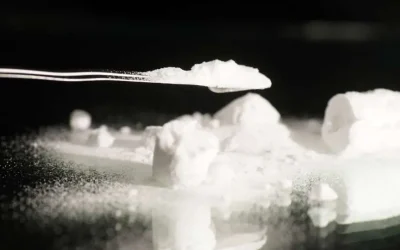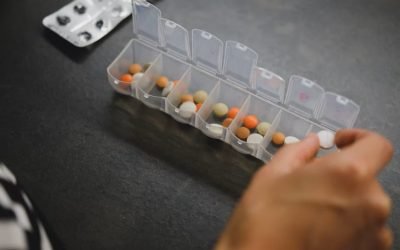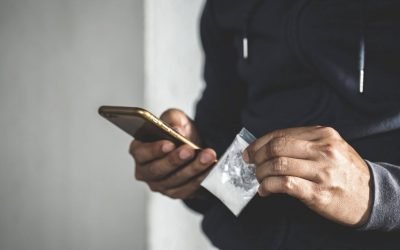Last updated: November, 2025
They promise euphoria, a few hours of excitement, curiosity, or escape. Yet the danger of designer drugs addiction lies not in excess, but in illusion. Created in laboratories to mimic known substances, these so-called research chemicals or New Psychoactive Substances (NPS) often carry unpredictable, hidden effects.
What begins as experimentation can evolve into synthetic drugs dependence that alters the body, the brain, and emotional stability. For many, the turning point comes quietly: sleep begins to fade, anxiety rises, and moments of confusion stretch into days.
Understanding what these substances are (and what they truly do) is the first step towards recovery and protection.
What Are Designer Drugs?
The first drugs humans used came from nature, plants like opium, cannabis, or coca leaves. As chemistry advanced, scientists learned to reproduce and modify these natural compounds in laboratories. Small molecular changes could produce new sensations, new effects, and entirely new risks.
These are known as designer drugs, also called research chemicals or new psychoactive substances (NPS): compounds engineered to imitate existing drugs such as MDMA, cocaine, or LSD. Because each variant changes its molecular structure slightly, producers often bypass regulation until new bans appear.
From Plant-Based Substances To Laboratory Creations
For centuries, humans relied on plants for stimulation or relief. Opium soothed pain, coca boosted energy, and cannabis altered perception. The evolution of chemistry made it possible to copy and change these natural compounds, creating new ones entirely. Today, a laboratory can synthesize hundreds of variants in weeks: substances that mimic natural effects but carry risks that no plant ever held. This transition from organic to synthetic has changed not only how drugs are made, but how unpredictable their impact can be.
What “Research Chemicals” And NPS Really Mean
The label research chemical often misleads users into thinking the substance has been tested or approved. In reality, most new psychoactive substances (NPS) exist in a legal grey zone: not yet regulated, but far from safe. Their ingredients vary with each batch, and their effects differ from person to person. Some overstimulate the heart; others suppress breathing. Because their production is unregulated, even experts cannot predict how a body will react. Calling them “research” does not make them controlled, it makes them unknown.
Common Examples Of Designer Drugs (3-MMC, 4-MMC, 2C-B, Synthetic Cannabinoids, GBL)
Among the best-known designer drugs are 3-MMC, 4-MMC (mephedrone), 2C-B, synthetic cannabinoids, and GBL; each representing a distinct chemical family, each carrying unique risks.
3-MMC and 4-MMC, both stimulants, are often compared to MDMA or cocaine. They raise heart rate and blood pressure while flooding the brain with dopamine and serotonin. The result is a brief feeling of euphoria and confidence, followed by exhaustion, irritability, and depression once the chemical surge fades. Repeated use quickly builds tolerance, pushing the body into overdrive.
2C-B belongs to the psychedelic class. It alters visual perception, distorts time, and intensifies emotions, sometimes pleasantly and sometimes painfully. The experience can shift from fascination to panic in seconds. Because the line between dose and overdose is thin, reactions are unpredictable and, at times, traumatic.
Synthetic cannabinoids are far more potent than natural cannabis. Marketed as herbal blends or “Spice,” they bind to brain receptors with overwhelming force. Users report sudden paranoia, heart palpitations, and loss of consciousness. What appears to be a milder alternative to THC can, in reality, provoke psychosis or collapse.
Finally, GBL, a close chemical relative of GHB, acts as a depressant. At low doses it produces relaxation; at slightly higher ones, sleep or complete unconsciousness. It is extremely habit-forming. Withdrawal from GBL can trigger tremors, anxiety, and seizures, making medical detox essential.
What unites all these substances is unpredictability. The same dose may calm one person and endanger another. Their appeal lies in curiosity; their risk lies in chemistry. Over time, each can lead to addiction to new psychoactive substances, a condition that touches not only the brain but the emotions and relationships that hold life together.
The Hidden Risks Of Designer Drugs
At first glance, the term “designer” sounds sophisticated. But behind the chemistry lies unpredictability: a substance that may calm one person and endanger another.
The Effects Of Synthetic Substances: From Euphoria To Long-Term Damage
At low doses, these designer drugs effects can include euphoria, enhanced senses, and emotional openness. Yet even short-term use may bring panic, hallucination, or loss of control.
With time, repeated designer drugs abuse erodes the nervous system. Users may experience nerve damage, memory loss, poor coordination, and anxiety. Because these substances often deplete vitamin B12 and alter neurotransmitters, long-term consequences include fatigue, depression, and emotional instability.
Unlike regulated medicines, designer drug toxicity cannot be predicted or reversed easily. One dose can differ from the next. One experience can end in hospitalisation.
Can You Become Addicted To Designer Drugs?
Dependence develops quietly. Synthetic substances act on dopamine and serotonin — the brain’s chemistry of pleasure and calm. With repetition, the mind begins to crave the feeling, and the body learns to rely on it.
As tolerance builds, users take more for the same result. When the drug wears off, designer drug withdrawal symptoms appear: trembling, nausea, insomnia, or sadness. Stopping without help can be dangerous, especially with GHB or 3-MMC.
Warning Signs Of Addiction: Physical And Emotional Cues
Addiction to research chemicals rarely arrives suddenly. Early signs of research chemicals addiction show up in subtle ways: using more often, sleeping less, or feeling anxious without the substance. Concentration fades, emotions flatten, and relationships begin to slip away. Physically, the body starts sending warnings: tremors, numbness, loss of appetite. Emotionally, people describe feeling disconnected from themselves, as if watching life through glass. These signs are invitations, not condemnations; signals that it’s time to seek help before the damage deepens.
Withdrawal And Relapse: Why Supervised Detox Matters
A safe detox for designer drug addiction is not only about removing toxins; it’s about re-establishing safety. When withdrawal happens without supervision, blood pressure, sleep, and emotional balance can fluctuate dangerously. Medical professionals provide structure (hydration, nutrition, and calm) allowing the body to heal without shock. Beyond the physical, supervised detox offers emotional containment: someone present, attentive, guiding each step. This combination of care and control makes the difference between suffering and healing.
The Emotional And Physical Cost Of Dependence
Beyond the visible symptoms, addiction to synthetic drugs carries emotional pain. The cycle of use and regret often leads to isolation and shame. Sleep disturbances, anxiety, and cognitive fog become part of daily life.
These effects do not mean weakness; they reveal how powerful designer drug dependence can be on the nervous system. Recovery begins when the person recognises that help is not punishment, it is care. Compassion opens the door to change.
Treatment For Designer Drugs Addiction: The Path To Recovery
Recovery requires more than stopping. It means restoring what dependence has taken: stability, emotion, and peace. Treatment for designer drug addiction addresses both physical and psychological recovery, helping individuals rebuild confidence and clarity.
Professional Detox And Medical Supervision
A detox for designer drug addiction is the foundation of recovery. Doctors monitor oxygen levels, heart rhythm, and mental state while supporting the body’s natural detox process. Nutritional therapy replenishes vitamins depleted by use, especially B12, which protects the nervous system. Supervised detox is not a punishment or isolation; it’s an act of restoration. It gives the body permission to rest, and the mind the space to begin again.
Psychological Therapy And Emotional Integration
Detox heals the body; therapy heals the narrative. Most people who fall into designer drugs addiction were searching for relief, not risk. In therapy, that search is re-examined with compassion. Patients explore the emotions or traumas that once made escape feel necessary. Through counselling, mindfulness, and group connection, they learn to meet those feelings safely. Integration means learning not to suppress emotion, but to understand it: turning pain into presence, and presence into peace.
Healing The Nervous System And Restoring Balance
Once the substance is gone, the body begins to speak again. Recovery involves repairing the neural pathways affected by synthetic drugs dependence. Physiotherapy supports movement; nutritional care rebuilds energy; relaxation techniques reduce overstimulation. Slowly, the mind’s chemistry recalibrates. Each night of proper sleep, each day of balanced rhythm, becomes part of the healing. It’s not about erasing the past, it’s about giving the nervous system a chance to trust life again.
Life Beyond Chemicals: Learning To Feel Again
When someone enters recovery, one of the greatest fears is emotional emptiness: the idea that without the substance, life will lose colour. But as clarity returns, emotions begin to expand rather than fade. Simple things (a walk, a conversation, the warmth of sunlight) start to feel meaningful again. Rehab for designer drugs addiction in Spain, especially at Hacienda Paradiso, offers space to rediscover what real calm feels like. At Hacienda Paradiso, residents learn that joy doesn’t have to be manufactured; it can be remembered. To feel deeply is not to lose control, it is to come home to oneself.
Healing In Harmony With Nature: Recovery At Hacienda Paradiso, Málaga
Set in the Andalusian countryside, Hacienda Paradiso unites medical precision with natural serenity. Here, healing from designer drugs addiction takes place in an eco-rehab designed for dignity, privacy, and connection with nature.
Recognised by World’s Best Rehab Awards as Best Addiction Rehab in Europe & Spain (2024) and Most Affordable Luxury Rehab in Europe (2022), Hacienda Paradiso offers more than detox: it offers renewal. Each programme blends evidence-based medicine with holistic therapies: counselling, mindfulness, nutrition, and rest.
Surrounded by olive trees and mountain light, residents learn to listen again: to their breath, to their body, to the silence that replaces craving. Recovery becomes not only possible, but peaceful.
A Gentle Reminder: Recovery Is Always Possible
Frequently Asked Questions: Designer Drugs Addiction
Designer drugs, also called research chemicals or new psychoactive substances (NPS), are synthetic compounds created in laboratories to mimic the effects of known drugs like MDMA, LSD or cannabis. Their chemical formulas change constantly to bypass regulation, making their strength and safety unpredictable.
Many appear legal because new formulas take time to be banned. Yet legality never means safety. These substances are rarely tested for human use, and their purity varies with every batch. Even a single dose can trigger overdose, anxiety, or neurological damage.
The brain quickly adapts to synthetic stimulants and sedatives, creating dependence after short use. People may develop cravings, anxiety, or physical withdrawal when they stop. Some, like GBL or 3-MMC, can cause both psychological and physical addiction that requires medical detox and therapy.
Withdrawal can include trembling, fatigue, nausea, restlessness, and insomnia. Emotionally, individuals often feel anxiety, low mood, or irritability. Because symptoms vary by substance, a supervised detox in a clinical setting is the safest way to manage them.
In many cases, yes, particularly if treatment begins early. Restoring vitamin levels, improving nutrition, and addressing nerve damage through medical care can promote recovery. Psychological support helps rebuild confidence and emotional stability over time.
Their main danger lies in unpredictability. Each compound is slightly different, so the body can never anticipate how it will react. Unlike natural substances, laboratory-made drugs often have stronger, faster effects that overwhelm the nervous system.
Treatment for designer drug addiction includes supervised detox, medical assessment, and psychological therapy. The goal is to stabilise the body, understand the emotional causes of use, and rebuild a healthy routine. Recovery programmes like those at Hacienda Paradiso combine medical precision with emotional care.
During detox, medical professionals monitor sleep, hydration, and heart rate while supporting the body with nutrition and vitamins. Withdrawal is managed gently, and therapy begins once the body stabilises. This process helps prevent relapse and restores physical balance.
Absolutely. The brain has remarkable capacity to heal, especially in younger users. Early intervention and comprehensive treatment (medical, psychological, and environmental) can reverse much of the damage. The key is seeking help before dependence becomes chronic.
Hacienda Paradiso offers a unique approach to recovery in southern Spain: evidence-based medical care within an eco-luxury environment. Here, patients receive individualised treatment surrounded by nature, privacy, and compassion. Recognised by World’s Best Rehab Awards in 2022 and 2024, it is a sanctuary for those seeking genuine healing from designer drugs addiction.








